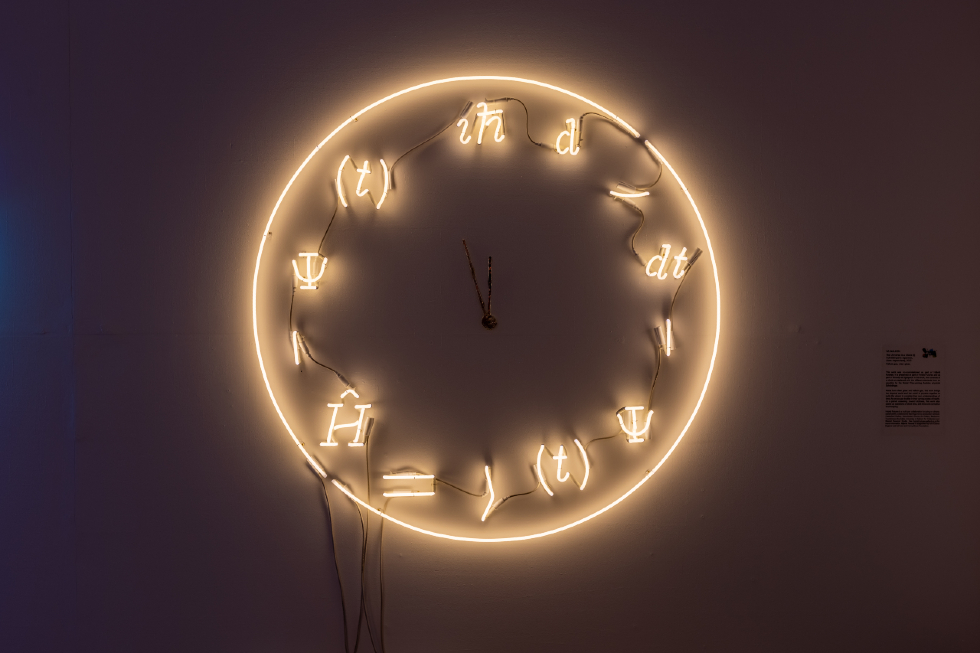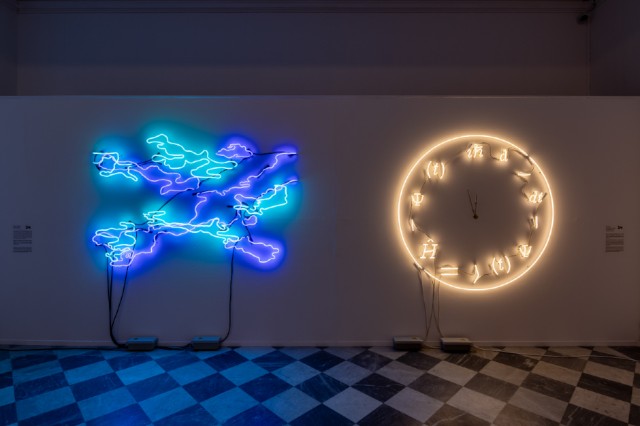How Soon is Now – The Strange Case of RA Walden’s Ghost Clock

How can we learn to see the artificiality of time for what it is? Mike Pinnington considers the work of RA Walden, an artist bringing new perspectives to the fragility of the body and the ticking of the clock…
The neon sculpture shimmers and glows with a strange symbology; the not quite immediate realisation that the familiar numerals of an analogue clock have been replaced with cryptic hieroglyphs is to feel the ground shift a little beneath your feet. Suddenly, time, and by extension how we experience and perceive it, is unexpectedly rendered that bit less fixed than it was before you stepped through the gallery door.
Shaken in a way you don’t quite understand, you glance at your watch for reassurance. To get the measure of things. “Good. The numbers are still there. I can decipher them,” you think. It’s 2.37pm. Everything is as it should be. You are once again moored in this reality. This time zone. The train you plan to travel home on will still abide by the timetable. More or less. But a nagging sense of the uncanny remains.
Such is the power of art: to pull the rug out from under us; to provoke us; it lifts the veil so that we see things differently, slightly askew; it reminds and encourages us to question… everything.
Even time, which, since the onset of the Industrial Revolution, has been a means to organise – some may say control, our waking hours. Keep us regimented. This is the universe is a clock (i) schrödinger’s equation, time dependent (2023) by RA Walden. That it is displayed at Blackpool’s Grundy Art Gallery alongside Shezad Dawood’s Island Pattern (2017) – a vivid illustration of climate change and rising sea levels – means a sense of urgency is injected into the unease already wildly sloshing around.

Walden, an artist whose work, which includes sculpture, installation, video and print, centres a queer, disabled perspective on the fragility of the body. They were commissioned as part of Hybrid Futures, a collaboration between Manchester’s Castlefield Gallery, Grundy Art Gallery, Touchstones Rochdale, University of Salford Art Collection and Shezad Dawood Studio, with a focus on, among other things, climate and sustainability.
But their work is more complex than a blunt call to arms in the context of climate catastrophe; it practically radiates with gnomic possibility, implying a myriad of potential readings. Its text panel informs us that the symbols standing in place of the hours more commonly found on a clock face are in fact the different elements from an equation by the Nobel Prize winning Austrian physicist Erwin Schrödinger (he of the simultaneously dead and alive cat).
In bringing ‘the physical world and the world of physics together’, RA Walden invites us to consider more closely our own perception of time, how it affects us and what that means. We’re reminded that our notion of time is a construct – physicists have shown that time is variable and non-linear. And while we have been trained to experience it as endlessly flowing in one direction, it is not fundamentally real. It is both mechanism and trap. Time is money.
Knowing this intellectually doesn’t make it any easier to grasp, so successful has been our training (since birth) to be conscious of, and bow down to the ticking of the clock. And one can’t help but consider the connection between the Industrial Revolution and the increased/mechanised burning of fossil fuels. Time, instilled by man in the past, has had a significant causal relationship with the running down of the environmental clock today, heralding the end of the world as we know it that we face in the near future.
But Walden urges us to look at how we might experience the tyranny of time differently and to acknowledge how our own and others’ expectations and management of time differs depending on circumstance; from age and occupation – or otherwise – to our relative health. The nature of time is changeable. Contrary. We saw it concertina during Covid and the national lockdowns; and we know that, pretty much universally, summers in childhood seem endless. Writing this from the vantage point of middle age, however, is to sometimes feel that time – no matter the season – is a collection of snatched, fleeting moments amid the blur of life’s maelstrom.
There will be almost as many readings of Walden’s work as there are viewers. But the meaning – whatever our take – is only half of the story. Made using Argon, the version I encountered in December of 2023 was not as initially intended. It had a predecessor made, unusually, using Helium gas. Grundy curator Paulette Brien tells me that its appearance was fleshier, and that it pulsed with greater movement, indicating a certain instability in keeping with and emphasising the artist’s concerns. Ultimately, though, the first iteration of the universe is a clock (i) schrödinger’s equation, time dependent, failed after 24hrs – this very instability and its lack of fixity its downfall.
A disaster, then. Well, not quite, as it turns out. Rarely can such a failure or breaking of a work as envisioned by artist and commissioner alike be considered opportune. But in this case, there is a certain poetry, even a serendipity in the outcome, as outlined in a statement (fittingly titled This Clock Has Stopped) made by the Grundy:
“The artist RA Walden chose Helium specifically for this work as, in its stage of excitement, Helium glows a soft pale pink and more closely resembles colours found in nature than, for example, the bright red and blue of excited Neon and Argon.
“As this artwork is asking us to think about the sickness of the planet, the fragility of our bodies, and our relationship to time, Helium was chosen to mirror the themes of the work. The unexpected short lifespan of the work also provides pertinent emphasis to the theme of instability.”
The resulting ‘ghost work’, as Brien aptly refers to it, simultaneously haunts and enriches our experience; the implication being that the stricken, non-identical first-born twin, will no longer show nor dance to time’s tune.
Mike Pinnington
The final phase of Hybrid Futures takes place at Salford Museum & Art Gallery 23 March – 22 September 2024; RA Walden: Object Transformations Through the Coordinate of Time opens 20 April at Grundy Art Gallery
Images courtesy the Grundy and © the artists





